In the world of finance, trading doesn’t stop when the stock market closes. After-hours trading allows investors to buy and sell securities outside the standard trading hours of major exchanges like the New York Stock Exchange (NYSE) and the Nasdaq. But what exactly does after-hours trading entail, and how does it influence stock prices?
Understanding After-Hours Trading
After-hours trading typically occurs from 4 PM to 8 PM EST, following the regular market hours of 9:30 AM to 4 PM EST. This extended trading period allows investors to react to news and events that may occur after the market closes, such as earnings reports, economic data releases, or geopolitical events.
How Does It Work?
After-hours trading is facilitated by electronic communication networks (ECNs) that match buyers and sellers directly. Unlike the regular market, where orders are matched in a centralized exchange, ECNs allow for trading in a more decentralized manner. This means trades can be executed even if the official market is closed, providing greater flexibility for investors.
Key Features of After-Hours Trading
1. Less Liquidity: One of the most significant differences in after-hours trading is liquidity. There are typically fewer participants, leading to wider bid-ask spreads and potentially more volatile price movements.
2. Price Volatility: Prices can fluctuate dramatically in after-hours sessions. An earnings report that beats or misses expectations can lead to substantial price changes in a short period.
3. Limited Order Types: Most after-hours trading platforms allow only limit orders to prevent unexpected price movements.
Does After-Hours Trading Influence Stock Prices?
Immediate Impact After-hours trading can have a significant immediate impact on stock prices. For instance, if a company reports better-than-expected earnings after the close, the stock may jump in price during after-hours trading. Conversely, disappointing news can lead to a sharp decline. These price movements can create a ripple effect when the market opens the next day, influencing the stock’s opening price and potentially its trajectory for the following days.
Market Sentiment After-hours trading can also reflect overall market sentiment. If a majority of trades during this time are bullish (buying), it may indicate positive investor sentiment that could carry over into the next trading day. Conversely, bearish trading activity can signal caution or pessimism among investors.
Influence on Analysts and Institutions Institutional investors and analysts often monitor after-hours trading closely. Significant movements can prompt them to adjust their recommendations or target prices based on the latest information. This can further influence trading behavior when the market reopens.
Risks of After-Hours Trading
Despite its advantages, after-hours trading comes with risks:
– Higher Volatility: The lower volume can lead to sharp price movements that may not reflect the underlying value of the stocK.
– Less Transparency: With fewer participants, it can be challenging to gauge the true market sentiment.
– Emotional Trading: Investors might react impulsively to news, leading to poor decision-making.
After-hours trading offers a unique opportunity for investors to respond to news and events outside regular trading hours. While it can influence stock prices significantly, it also comes with increased volatility and risks. Understanding these dynamics is crucial for anyone looking to participate in after-hours trading. As with all investment strategies, informed decision-making and risk management are key to navigating this complex landscape.





